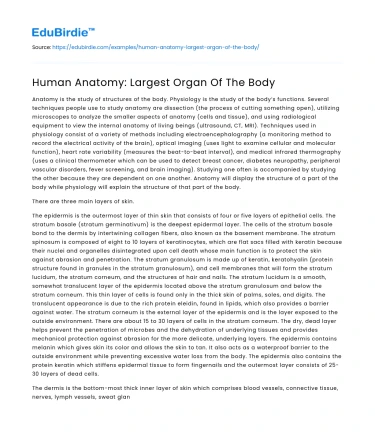Anatomy is the study of structures of the body. Physiology is the study of the body’s functions. Several techniques people use to study anatomy are dissection (the process of cutting something open), utilizing microscopes to analyze the smaller aspects of anatomy (cells and tissue), and using radiological equipment to view the internal anatomy of living beings (ultrasound, CT, MRI). Techniques used in physiology consist of a variety of methods including electroencephalography (a monitoring method to record the electrical activity of the brain), optical imaging (uses light to examine cellular and molecular function), heart rate variability (measures the beat-to-beat interval), and medical infrared thermography (uses a clinical thermometer which can be used to detect breast cancer, diabetes neuropathy, peripheral vascular disorders, fever screening, and brain imaging). Studying one often is accompanied by studying the other because they are dependent on one another. Anatomy will display the structure of a part of the body while physiology will explain the structure of that part of the body.
There are three main layers of skin.
The epidermis is the outermost layer of thin skin that consists of four or five layers of epithelial cells. The stratum basale (stratum germinativum) is the deepest epidermal layer. The cells of the stratum basale bond to the dermis by intertwining collagen fibers, also known as the basement membrane. The stratum spinosum is composed of eight to 10 layers of keratinocytes, which are flat sacs filled with keratin because their nuclei and organelles disintegrated upon cell death whose main function is to protect the skin against abrasion and penetration. The stratum granulosum is made up of keratin, keratohyalin (protein structure found in granules in the stratum granulosum), and cell membranes that will form the stratum lucidum, the stratum corneum, and the structures of hair and nails. The stratum lucidum is a smooth, somewhat translucent layer of the epidermis located above the stratum granulosum and below the stratum corneum. This thin layer of cells is found only in the thick skin of palms, soles, and digits. The translucent appearance is due to the rich protein eleidin, found in lipids, which also provides a barrier against water. The stratum corneum is the external layer of the epidermis and is the layer exposed to the outside environment. There are about 15 to 30 layers of cells in the stratum corneum. The dry, dead layer helps prevent the penetration of microbes and the dehydration of underlying tissues and provides mechanical protection against abrasion for the more delicate, underlying layers. The epidermis contains melanin which gives skin its color and allows the skin to tan. It also acts as a waterproof barrier to the outside environment while preventing excessive water loss from the body. The epidermis also contains the protein keratin which stiffens epidermal tissue to form fingernails and the outermost layer consists of 25-30 layers of dead cells.
The dermis is the bottom-most thick inner layer of skin which comprises blood vessels, connective tissue, nerves, lymph vessels, sweat glands, and hair shafts. It also provides strength and elasticity to the skin. The dermis has two main layers. The upper papillary layer contains touch receptors that correspond with the central nervous system and is responsible for the folds of fingerprints. The lower reticular is made of dense elastic fibers that house hair follicles, nerves, and glands.
The hypodermis also named the subcutaneous layer, is a layer directly below the dermis and serves to connect the skin to the fibrous tissue of the bones and muscles. It functions as a mode of fat storage and provides insulation and cushioning for the integument. (J. Gordon Betts, 2013)
Understanding all of the levels of tissue within the skin would provide the best treatments for skin diseases by recognizing what tissues are being afflicted and their role within the skin, how to approach treatment of skin cancer (depending on what layer of skin is affected), and this information would further advance research within dermatology.






 Stuck on your essay?
Stuck on your essay?

